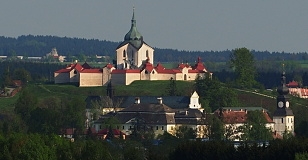The construction of the church
Considering the period and the project to construct such a splendid building, they started to build the church at an unusual time, in the middle of the building season, on 13 August 1719. But it probably concerned preparatory activities, such as measuring the area and digging and building bottom walls of the future church, whereas experts assume that the bottom walls were higher than the terrain. In the meanwhile, it was surely necessary to ensure considerable material deliveries for the next year and to make agreements with a sufficient number of specialists and day labourers so that everything would be without complications.
They quickly continued the next spring under the leadership of builder Jan Jakub Vogler from Kutná Hora. A foundation stone was placed on the site on 16 May 1720 and the building was probably constructed as early as 1721. It was finished in the following year. The sanctuary was temporarily equipped and decorated in the same year. The church was dedicated to St. John of Nepomuk on 27 September 1722 but this did not mean that the work on the church ended. It was necessary to finish the ambulatory whose bottom walls were probably still waiting covered with earth. The church also needed permanent equipment and decoration. According to the reports, the ambulatory was finished only around 1740. Tough winters in the 1760s resulted in slight and, luckily, relatively sensitive building adjustments of the ambulatory. Some of the portals from the hall to the courtyard were walled up and gate and chapel portals were lowered.

 Back to top
Back to top Search
Search